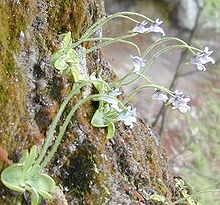Pinguicula ramosa
| Pinguicula ramosa | ||||||||||||
|---|---|---|---|---|---|---|---|---|---|---|---|---|

Pinguicula ramosa on Mount Koshin in Japan |
||||||||||||
| Systematics | ||||||||||||
|
||||||||||||
| Scientific name | ||||||||||||
| Pinguicula ramosa | ||||||||||||
| Miyoshi ex Yatabe |
Pinguicula ramosa is a carnivorous plant from the genus of fatty herbs ( Pinguicula ). It occurs exclusively on a mountain in Japan, its Japanese name is Kōshinsō (庚申 草 , dt. "Kōshin herb").
description
Habitus
Pinguicula ramosa forms a native rosette of five to seven leaves with numerous fine thread-like roots. The fleshy leaves are short-stalked, light green, spatulate to elliptical, blunt at the end and rolled up at the sides. They reach a length of 7 to 20 millimeters and a width of 5 to 10 millimeters. To hibernate, it forms a very small hibernacle from which it sprouts again in April.
blossoms
The 15 to 90 millimeter long, upright and hairy glandular flower stalks are branched at the base (unique in the genus) and bear two to three terminal zygomorphic flowers in June / July . Support and cover sheets are missing. The flowers reach a length between 7 and 11 millimeters. The upper sepal is deeply lobed in three parts, each lobe is 2 millimeters long. The lower sepal is in two parts, the lobes are ovate-lanceolate and covered with glands and up to 2.5 millimeters long. The corolla is purple or white, the upper petal is two-part and 1.5 to 2 millimeters long, the lower three-part lobed. The middle lobe of the lower sepal is noticeably large (3 to 4 millimeters long) and deeply edged in the middle, the side lobes around 1.5 millimeters long. The conical, slender spur reaches a length of 3 to 4 millimeters. The stamens are curved, the ovary round.
The inverted egg-shaped to elliptical capsule fruits reach a length of 2 to 4 millimeters and a width of 2 to 3 millimeters. The seeds are ellipsoidal, brown, around 1 millimeter long and 0.5 millimeters wide.
The chromosome number is 2n = 18 (also a unique feature in the genus).
Distribution, habitat, endangerment
Pinguicula ramosa grows endemically in the mountains of the Nikkō National Park , especially on the Kōshin Mountain , at altitudes between 1500 and 1900 m. It only colonizes weathered granite rocks in damp, misty locations in partially shaded to shady locations. Occasionally it is associated with Saxifraga fortunei and Primula modesta .
Their habitat was protected by law in 1921 and declared a special natural monument of Japan in 1952 .
Pinguicula ramosa is threatened by the disintegration of the granite rocks - promoted by acid rain and climbers - and by deer that eat the plants. Despite legal protection, the survival of the species is currently not considered certain.
Systematics
Pinguicula ramosa was first described by Manabu Miyoshi in 1890 . In 1953 Michio Tamura classified it as a pure variety of Pinguicula villosa , but this classification did not prevail. In his monograph on the genus, Casper placed it together with the Alpine butterwort ( Pinguicula alpina ), Pinguicula algida and Pinguicula variegata in the Micranthus section , the latter is considered to be its closest relative.
swell
- S. Jost Casper : Monograph of the genus Pinguicula L. (= Bibliotheca Botanica. H. 127/128, ISSN 0067-7892 ). Schweizerbart, Stuttgart 1966, p. 17.
- Yasuro Kadono: Pinguicula ramosa. In: Flora of Japan. Online , accessed August 11, 2007.
- Michiaki Mabuchi: Pinguicula ramosa.
- Information about the species on Pinguicula.org.
Individual evidence
- ↑ コ ウ シ ン ソ ウ 自 生地 . Bunka-chō , accessed January 21, 2015 (Japanese).
